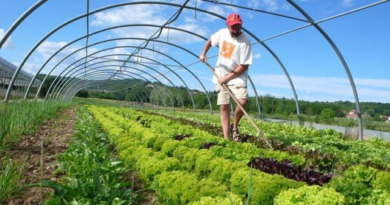Plant Tissue Culture Technician ( 6 month course)
Plant Tissue Culture

The Plant Tissue Specialist manages to perform the various tasks involved in the production of traditional tissue plants in the laboratory. Short Job Description: The Plant Tissue Specialist manages cultural resources, including labels / sample containers, inoculating, growing small cultures, incorporating tissue culture, hardening plants, storing laboratory equipment, cleaning laboratory equipment using proper cleaning procedures and procedures and procedures. of limited control Your Qualities: Plant Tissue Specialist should have good vision and good eye contact. Must / know how to operate in accordance with laboratory procedures. He must have a clear idea and must focus on the details. One must be able to read, perform many tasks, keep accurate records, follow instructions, and follow company policies Plant Tissue Culture.

Adhere to sanitation and safety guidelines of the lab Plant Tissue Culture:
In order to be competent, the user / person at work must be able to: PC1. understand the structure of the PC2 lab. identify the need for different areas / rooms and equipment Maintain personal hygiene and sanitation in the laboratory To be competent, the user / person on the job must be able to: PC3. ensure personal hygiene by using a clean lab coat, gloves, headgear, face masks, glasses, etc. as required for work PC4. avoid eating, smoking and drinking inside the PC5 lab. oversees lab cleaning operations and also does fumigation where PC6 is required. place the reagents / chemicals in their proper place, according to their PC7 properties. check and disinfect all tools and equipment before using PC8. discard the contents of the container immediately after completing the experimental PC9. Dispose of cracked or broken glassware in marked PC10 containers. clean / wash all glassware or with an automatic washing machine in PC11 drinking water. dry and stain the PC12 glassware. sterilization glassware etc. in PC13 hot air oven. clean and place tools and equipment in designated areas after using PC14. follow the work instructions for maintaining the required lab environment Ensure the safety of the board To be competent, the user / person on the job must be able to: PC15. use PC16 protection (PPEs). treat toxic chemicals with proper monitoring of PC17. remove the spilled chemicals immediately PC18. Dispose of chemicals, broken glass, bottles, pipes etc. in the right place PC19. follow the safety measures provided by the manufacturer when operating
Organizational Context:
The person at work needs to know and understand: KA1. how to work with collaborators with KA2 seniors. organizational needs and time management

B. Technical Knowledge Plant Tissue Culture:
The person at work needs to know and understand: KB1. lab design KB2. standard procedures for using different equipment on the KB3 board. a good lab makes KB4. importance of cleanliness and aseptic status on the KB5 board. methods of cleaning labs, extracting KB6. use of antibiotics, lab rage KB7. various chemicals, labware, machinery and its use of KB8. operation and maintenance of various materials / laboratory equipment KB9. first aid and its use Plant Tissue Culture
Core Skills/ Generic Skills:
The person at work needs to know and understand how to do this: SA1. state the details required for SA2 objectives. keep inventory and latest recording of all equipment, chemicals etc. SA3. report problems to the appropriate staff while Learning Skills A person at work needs to know and understand how to do this: SA4. get up to date on the latest trends in lab practices by reading the SA5 newspaper and magazine. read laboratory equipment manuals Oral communication (listening and speaking skills) The person at work needs to know and understand how to do this: SA6. maintain an active working relationship SA7. liaising with others such as company representatives, seniors and various other SA8 stakeholders. understand the details and understand its meaning SA9. seek the advice of the elders
The person at work needs to know and understand how to do it: SB1. make decisions about the affected workplace SB2. identify potential problems in performing tasks and take steps to prevent them from following work procedures Planning and Planning A person at work needs to know and understand how to do this: SB3. plan and organize a variety of customer service tasks A person on the job needs to know and understand how to do this: SB4. manage relationships with older people and co-workers Solving Problems An employee needs to know and understand how to do this: SB5. think about the problem, test possible solutions (s) and come up with the best solution (s) (s) SB6. identify quick creative and new solutions to delay delays Considered Thinking The person at work needs to know and understand: SB7. view and maintain SB8 tools and equipment. view and store aseptic space inside the SB9 moth. use, analyze, and evaluate information collected from observation, experience, consultation, or communication, as a guide to thought and action Critical thinking An employee should know and understand: SB10. take personal reading Plant Tissue Culture

Prepare and store culture media Plant Tissue Culture:
To be competent, the user / individual on the job must be able to: PC1. read and understand SOPs for preparing culture media PC2. get familiarized with the nature & composition of different kinds of culture medium and their suitability to different types of explants PC3. understand the composition of the required stock solutions for nutrient medium PC4. ensure that the lab chemicals and agar used for preparation of media are of specific grade PC5. ensure that the water used is double glass distilled, RO or demineralized PC6. prepare different stock solutions for nutrient medium of required constituents, strength & volume PC7. ensure availability of the following equipment’s: deep freezer to store stock solutions refrigerator to store chemicals, plant materials and short term storage of stock solutions storage tank for distilled water other equipment’s such as electronic weighing balance, hot plates, PH meter PC8. label & store/refrigerate the stock solutions at desired temperature PC9. prepare culture medium (White’s, MS, B5, N6, Kitsch’s) with required quantity of sucrose, agar, water and stock solution with the help of hot plate & magnetic stirrer PC10. calibrate medium’s pH at required level with pH meter using HCL or Nao solution PC11. dispense medium into culture bottles/jars either or with the help of automatic media dispenser PC12. label the culture bottles & register the details of the same in media register or computer PC13. maintain inventory of all lab chemicals, glass wares, consumables etc. PC14. check bench height and its suitability for work
To be competent, the user / person at work must be able to: PC15. autoclave media with limited temperature, pressure and PC16 autoclave length. complete syntax filters before the automatic use of PC17. Sort of stock-soluble chemical solutions with syntax filter PC18. transfer sterilization solution to automated media after cooling under aseptic conditions PC19. transfer custom bottles to the media storage room immediately after PC20 automation. see the culture within three days after the onset of any contamination with the virus before the release of PC21 vaccine. discard all lots in the event of a more than 3 percent guarantee guaranteed by PC22. remove contaminated bottles immediately to make PC23 automatically. record the details of the pollution of each newsletter prepared in the media register Plant Tissue Culture
Organizational Context:
The person at work needs to know and understand: KA1. effective working relationships and how to work with partners, customers and KA2 seniors. organizational needs and time management Plant Tissue Culture
Technical Knowledge:
The individual on the job needs to know and understand: KB1. fundamentals of plant propagation KB2. good laboratory practices KB3. various techniques in plant tissue culture & their applications KB4. different medium components- macronutrients, micronutrients, vitamins, amino acids, sugar, undefined organic supplements, solidifying agents, growth regulators etc. KB5. functions of medium KB6. different types of media like whites, murashige & slog, gamboge, kitsch etc. KB7. preparation of stock solutions for nutrient medium KB8. method of preparation of medium KB9. sterilization & storage of medium KB10. plant growth conditions & micro-climate maintenance KB11. physical screening of contaminants KB12. personal hygiene & lab sanitation KB13. operation and maintenance of various lab equipment KB14. controlled conditions of growth room KB15. handling of hazardous chemicals KB16. basics of media preparation, sterilization, storage and use KB17. operation and maintenance of hardening unit/mist chamber Plant Tissue Culture


Core Skills/ Generic Skills:
The person at work needs to know and understand how to do this: SA1. state the required particulars of record keeping and keep the SA2 process identification paper. report problems to the appropriate staff while Learning Skills An employee on the job needs to know and understand how to do this: SA3. up-to-date information on the latest technology used in tissue culture by reading the SA4 newspaper and magazine. Stay up to date with the latest brochures, pamphlets, and SA5 product information sheets. read the media / SOP preparation booklet Oral communication (listening and speaking skills) The person at work needs to know and understand how to do this: SA6. maintain an active working relationship SA7. liaising with others such as company representatives, seniors and various other SA8 stakeholders. understand the details and understand its meaning SA9. seek advice from adults B. Making Professional Skills Decisions A person at work needs to know and understand how to do it: SB1. make decisions about the affected workplace SB2. identify potential problems in performing tasks and take steps to prevent them from following work procedures Planning and Planning A person at work needs to know and understand how to do this: SB3. plan and organize a variety of Customer Lab Centricity activities A person on the job needs to know and understand how to do this: SB4. manage relationships with older people and co-workers Solving Problems An employee needs to know and understand how to do this: SB5. think about the problem, test possible solutions (s) and come up with the best solution (s) (s) SB6. Find shocking and new solutions to delay delays Thinking Consideration A person at work needs to know and understand: SB7. view and maintain lab tools and equipment
Prepare explants for tissue culture, acclimatize plantlets and check for hardening Plant Tissue Culture:
In order to be competent, the user / person at work must be able to: PC1. select mother plants that can undergo micropropagation such as: agricultural crops: fruits and vegetables ornamental plants and flowers food grains such as wheat and rice palm palms spices PC2. ensure that mother plants are planted in a glasshouse / greenhouse holding area where PC3 is possible. exposing plants to appropriate light, temperature to improve the quality of PC4 testers. do irrigating the plant with filtered water or make a pretreat with recommended fungicides where possible to prevent PC5 bacterial contamination. choose a mother plant that looks healthy and free from pests, diseases and infections caused by PC6 bacteria. Label the mother plant and give the ref no / date, plant name, variety and location PC7. lift the mother plant (dried or immersed in water) in cardboard boxes and take it to the PC8 tissue laboratory. keep the plant susceptible to infection until it is used in tissue functioning Prepare for inoculation explosions In order to function properly, the user / person at work should be able to: PC9. select the part of the plant that will be used as an explosive for cultural purposes such as: shooting tip Plant Tissue Culture
auxiliary shoot flower buds / small inflorescences / fruit nodules rhizomes leaves etc. PC10. remove part of the plant that does not change in sterile PC11 state. ensure that the cutting tools used to remove plant parts are infected PC12. clean the area of the part with a cleaning spray in running water PC13. lubricate the explosive surface with a disinfectant such as a solution of “sodium hypochlorite” or other solutions determined under sterile housing conditions PC14. rinse the surface over time with sterile water to remove all traces of disinfectant Fix the explant and establish basic customs For proper operation, the user / person on the job must be able to: PC15. ensure that the vaccine chamber is maintained for PC16 level of inactivity. adjust work space (Laminar Air Flow Cabinet) or lab bench with a microscope, by wiping with disinfectant, clean glassware, tools and PC17 equipment. prepare explosives, Vaccinate wounded / cut into custom tubes / bottles containing growth area under aseptic conditions PC18. labels / bottles providing information on plant species, variety, PC19 transfer date. insert tubes / bottles with sterile plug or other suitable caps and / or wrap with cling / parafilm to reduce free exchange of sterile PC20 air. ensure the establishment of basic cultures – check first pollutants, leachates, phenolics etc., discard contaminated practices Make small repetition rituals for shooting To be competent, the user / person at work should be able to: PC21. insert the customized vaccine tubes for 3-4 weeks, keeping appropriate conditions such as: temperature humidity light and light other conditions necessary for the growth of shoots PC22. transfer / subculture growing shoots to a new area of high density where PC23 is needed. keep a worksheet showing the number of bottles transferred at the end of the complete transfer of each clone / genotype, indicating the number of bottles, not the subculture etc. PC24. store custom trays or racks in the PC25 storage room. check and measure room temperature regularly using PC26 temperature sensors. keep stock customs in the refrigerator / in controlled conditions to continue

PC PC duplication. store custom stock information in a specific PC28 register. see growth and pollution during weekly PC29. transfer shoot shoots to other nutrient-specific nutrients for PC30 root growth and root growth. see root and shoot growth and vision recording assemble clothes and transfer to pots In order to work properly, the user / person at work should be able to: PC31. remove plantlets from bottles / custom tubes after obtaining sufficient growth and rooting PC32. wash plantlets to remove any traces of PC33 media. ensure that tissue culture plants are planted in the soil / soil trite / sand-microplots for PC hardening primary. ensure that plants are labeled and tagged PC35. check the temperature and humidity of the facility and make sure that the strength of the PC36 plants is correct. Keep track of the need for water and a plant fertilizer program Check the strength of the plants For them to work properly, the user / person at work should be able to: PC37. ensure that plants are kept indoors in a green house or in a shady theme with controlled climatic conditions such as relative humidity, temperature, strong light and air distribution PC38. keep a check on continuous / continuous intensity for less than six weeks PC39. make a standard plant health check PC40. ensure that the plants are transferred to large pots / pots with soil and compost, if they appear to be healthy with new leaves and improved roots of PC41 second firmness. see water requirements and plant fertilization program regularly with PC42. label logs showing plant species / varieties of PC43. watch the plantlets for their growth and the presence of any PC44 infection. remove dead / decaying clothing Plant Tissue Culture

Organizational Context:
The person at work needs to know and understand: KA1. effective working relationships and how to work with partners, customers and KA2 seniors. organizational and time management requirements KA3. organizational methods used in plant tissue culture
Technical Knowledge Plant Tissue Culture:
The person at work needs to know and understand: KB1. basic plant distribution KB2. different methods of crop distribution KB3. micropropagation techniques
KB4. good laboratory practices KB5. various techniques in plant tissue culture and their applications KB6. methods of separation, measurement, placement of KB7. the use of tissue culture in agricultural science KB8. crop growth conditions & micro climate retention micro9. personal hygiene and lab hygiene lab10. operation and maintenance of various laboratory equipment KB11. Ascetic conditions required in tissue culture KB12. the most important conditions required for plant tissue culture KB13. methods of inoculation and incubation KB14. ways to prevent cultural pollution KB15. government schemes and support for KB16 tissue culture. contraceptive strategies KB17. nutritional requirements for healthy tissue growth in vitro KB18. various hardening techniques KB19. operation and maintenance of unit stability Plant Tissue Culture
Core Skills/ Generic Skills:
The person at work needs to know and understand how to do this: SA1. record and store information on the process of making plant tissue culture Learning Skills An employee needs to know and understand how to do it: SA2. read internal information documents sent to internal parties SA3. read the resources manual and reference works to understand the functioning of equipment’s and the process that requires oral communication (listening and speaking skills) An employee needs to know and understand how to do this: SA4. contact colleagues to collect materials SA5. discuss job lists, schedules and tasks with manager B. Creating Professional Skills To make a working person need to know and understand how to do this: SB1. make decisions about the selection of the living part of the plant to be used as Explant Plan and edit A working person needs to know and understand how to do this: SB2. edit and edit work order and tasks obtained from the SB3 manager. plan and focus on work based on instructions received from the manager

SB4. plan to use time effectively
Customer Location
The person at work needs to know and understand that:
SB5. manage relationships with co-workers and employees
SB6. maintain good relationships with customers
Problem solving
The person at work needs to know and understand that:
SB7. think about the problem, explore possible solutions and suggest i
excellent solutions
SB8. Find quick fixes for design delays
Analytical thinking
The person at work needs to know and understand that:
SB9. monitor and maintain the condition of laboratory tools and equipment
SB10. Insert, analyze, and view data collected in the view,
experience, consultation, or communication, as a guide for thought and action
SB11.apply domain information about cultural and monitoring and conservation strategies
types and materials
Critical thinking
The person at work needs to know and understand that:
SB12.use mind and make daily judgments Plant Tissue Culture
SB13. Use thinking skills to identify and solve basic problems
Guidelines for Assessment:
- Criteria for assessment for each Qualification Pack will be created by the Sector Skill Council. Each Performance Criteria (PC) will
be assigned marks proportional to its importance in NOS. SSC will also lay down proportion of marks for Theory and Skills Practical
for each PC - The assessment for the theory part will be based on knowledge bank of questions created by the SSC.
- Assessment will be conducted for all compulsory NOS, as well as the selected elective NOS/set of NOS.
OR - Assessment will be conducted for all compulsory NOS, as well as the selected optional NOS/set of NOS.
- Individual assessment agencies will create unique question papers for theory part for each candidate at each
examination/training center (as per assessment criteria below) - Individual assessment agencies will create unique evaulations for skill practical for every student at each examination/training
center based on this criteria - To pass the Qualification Pack , every trainee should score a minimum of 70% of aggregate marks to successfully clear the
assessment. - In case of unsuccessful completion, the trainee may seek reassessment on the Qualification Pack







